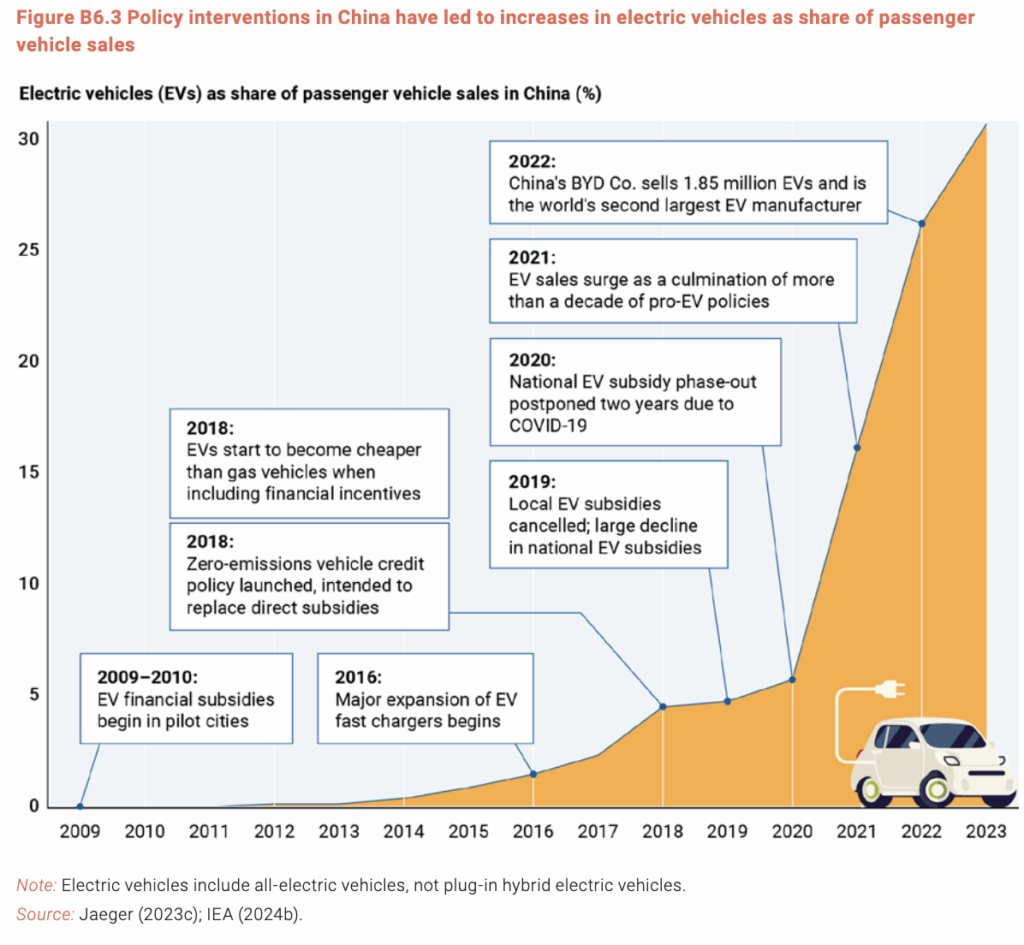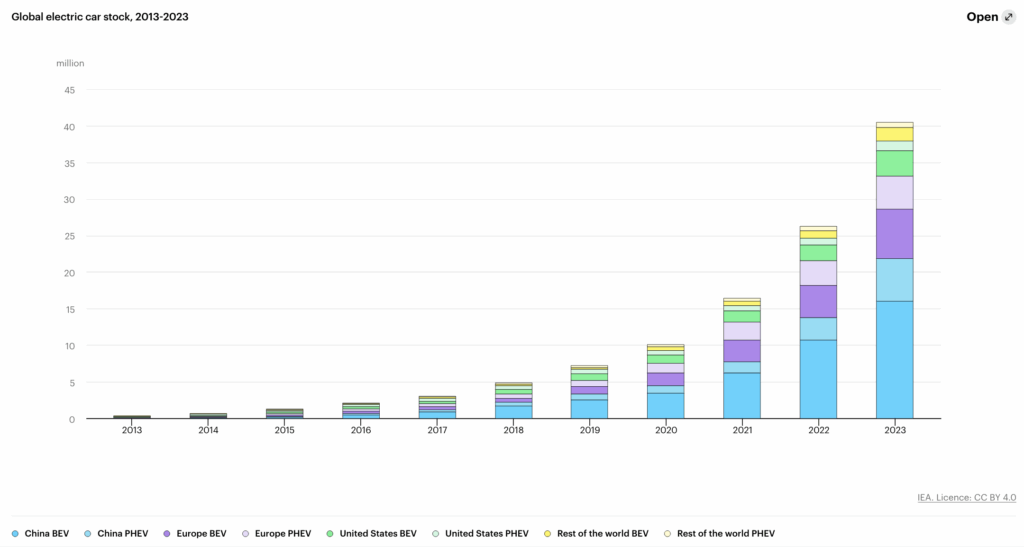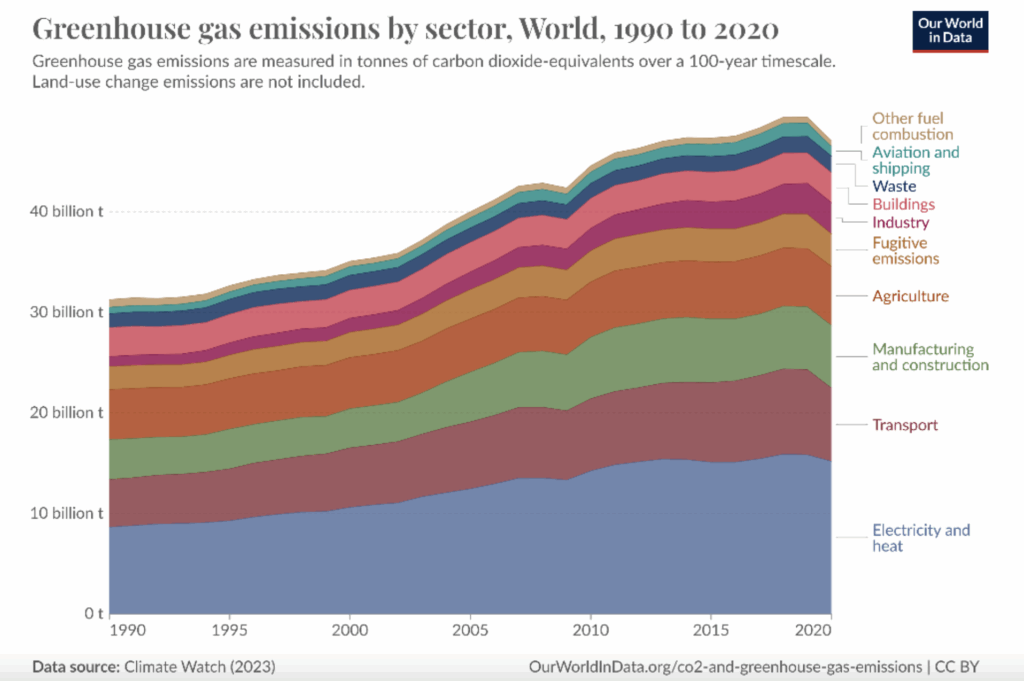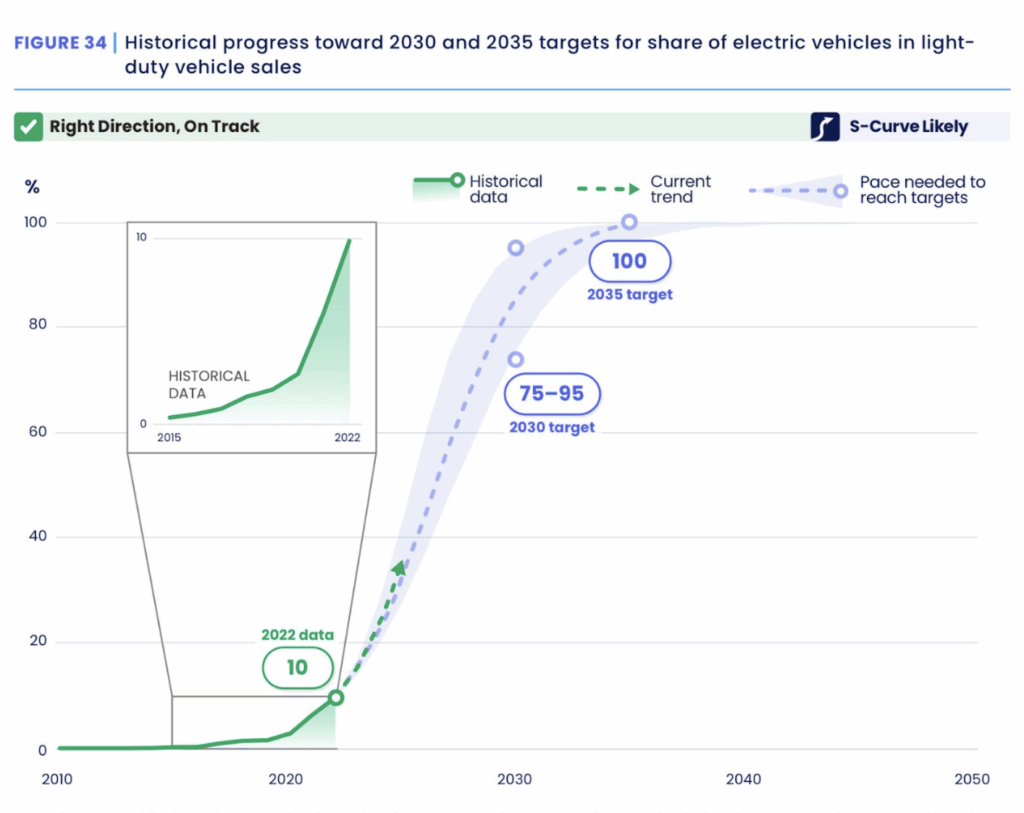“In five years, electric vehicles’ share of new car sales has grown exponentially […] from 1.6% of sales in 2018 to 10% in 2022.” This encouraging news highlighted in the Climate Action Tracker 20231 report is rare enough to be worth mentioning. Among the 42 indicators of effective climate change mitigation (limiting it to 1.5°C), this is the only one that is on track: electric cars should account for 75–95% of sales in 2030 and 100% in 2035. “This assessment is justified, as road transport began its transition earlier than other sectors,” says Jean-Philippe Hermine. For Anne de Bortoli, however, this requires a caveat: “This indicator alone does not demonstrate a massive shift from combustion engine vehicles to electric vehicles, as it could also reflect a steady and sustained increase in transport demand.”
Transport is responsible for around 14% of global greenhouse gas (GHG) emissions, and its contribution is expected to increase in the future. The majority of these emissions are due to road transport, which accounts for around 12% of global emissions. The transformation of the sector is essential to mitigate climate change, and electrification plays a key role2. Over their lifetime, electric cars emit less GHG than combustion engine cars in most countries3.
How has the automotive industry managed to get on the right track? “Most developed countries have relatively ambitious targets and political will when it comes to electric cars,” says Anne de Bortoli. Jean-Philippe Hermine adds: “Electric cars are an existing and economically attractive technological solution for decarbonising the transport sector. They also offer co-benefits, such as improved air quality and reduced dependence on imported fossil fuels.” Most of this rapid growth in sales is being driven by countries that have prioritised electric vehicle sales in their political agendas, as highlighted in the Emission Gap Report 20244: For example, in 2023, electric cars accounted for 93% of car sales in Norway, 74% in Iceland, 60% in Sweden, 54% in Finland, 41% in Belgium and 38% in China.

“Nearly two-thirds of global electric car sales are in China,” points out Anne de Bortoli. “This is not a coincidence: the country has been developing policies to promote electric vehicles since the 2000s, including subsidies for production and purchase.” These policies have enabled the country to develop a competitive advantage in the manufacture of electric vehicles, while also reducing air pollution and oil imports. In the European Union, the goal of banning the sale of combustion engine vehicles by 2035 sends a clear signal to the automotive industry, and some countries have even shortened the deadline to 2030 (the Netherlands, Ireland, Slovenia and Sweden6). The Climate Action Tracker highlights other countries that are performing well in this area: Indonesia, India and South Africa.
In emerging countries, the International Energy Agency (IEA) notes that electric vehicles still account for a relatively small share of the car market, but several factors point to further growth7. “In India, production-related incentives are supporting domestic manufacturing. In Brazil, Indonesia, Malaysia and Thailand, cheaper models, mainly from Chinese brands, are driving the adoption of these vehicles. In Mexico, supply chains are developing rapidly, boosted by access to subsidies under the US Inflation Reduction Act,” says the IEA. Anne de Bortoli adds: “Future transport demand scenarios show that emerging countries would account for only a third of transport-related greenhouse gas emissions. The challenge of electrifying these vehicle fleets is real, but less significant.”

In 2023, 18% of cars sold worldwide were electric. That’s a total of 14 million sales, with 95% of those in China, Europe, and the United States. Are we already seeing the benefits? According to Transport & Environment (an organisation promoting clean transport in Europe), the electrification of cars in the EU should prevent 20 million tonnes of CO2 from being released into the atmosphere in 20259. Transport emitted 1.05 billion tonnes of CO2 in the EU in 2024. “Total emissions from the transport sector are only marginally affected by the electrification of the car fleet, so we expect to see an impact a little later,” says Anne de Bortoli.

What is causing this? Increased demand for transport, but also the “SUVisation” of private cars. Two-thirds of electric models on the market are large vehicles or SUVs, according to the IEA. “In 30 years, cars have gained an average of 500 kg. The average weight of a car in the United States exceeds 1,900 kg, compared with 1,300 kg in the European and Chinese markets,” says Anne de Bortoli. “And GHG emissions per kilometre travelled are broadly proportional to the weight of the car.” Jean-Philippe Hermine adds: “SUVs now account for 60% of new car sales in Western Europe, up from 10% in 2010. This is a trend that public authorities have failed to monitor closely. They are now taking corrective action, with Europe, and France in particular, introducing measures such as weight-based penalties and eco-scores.” It should be noted that the decarbonisation of road transport does not rely solely on the electrification of private cars, but also on reducing the number of kilometres travelled by car in favour of active mobility or public transport. The phasing out of combustion engine cars must also be accelerated, by a factor of 7 by 204011.

The recent geopolitical context is hampering this positive momentum. “First of all, the debate is becoming increasingly polarised, and the political exploitation of electrification is undermining its momentum,” comments Jean-Philippe Hermine. “Added to this is the crisis in Ukraine and the sudden halt in progress in the US following Trump’s election.” Anne de Bortoli agrees: “Between the US withdrawal from the Paris Agreement and faint signals of corporate disengagement, I fear a knock-on effect from the Trump administration on the international stage. Across the world, there are also significant challenges around the availability of metals for electrification, whether in terms of mining capacity, reserves or resources.” According to the Climate Action Tracker, electric car sales projections are on track, although progress is still needed. The IEA notes that strong growth forecasts are stimulating investment. More than 20 major car manufacturers, representing over 90% of global car sales in 2023, have set electrification targets: “If we consider the targets of all major car manufacturers, more than 40 million electric cars could be sold in 2030, which would be in line with the level of deployment expected under current policies.”
“The rapid electrification of cars is a prime example of how political will can influence the success of the transition,” argues Anne de Bortoli. “It is crucial in motivating individuals to make the right choices.” Jean-Philippe Hermine concludes: “The main lesson is that the transition is systemic and requires commitment from all stakeholders. Positive public policy tools are needed because the transition has social and industrial consequences. Let’s create synergy, let’s take advantage of the environmental transition to address structural problems in the mobility sector, such as dependence on imports.”









